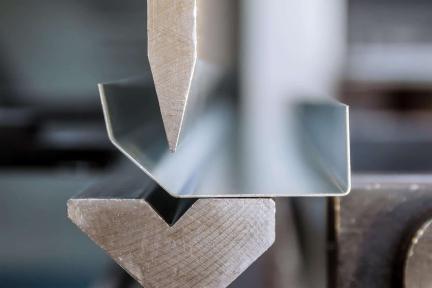What Is The Thinnest Sheet Metal? Machining and Application Guide
 Jul 09,2025
Jul 09,2025

Choosing the thinnest metal sheet that still stands up in service is part science, part shop experience. This guide walks from basic thickness classes to real CNC tactics, giving clear rules that help you hit weight targets without wrecking parts or budgets.

How Is Metal Thickness Classified? -Plate, Sheet, Foil
Before you pick a process, you must know which thickness band you are in. The breakpoints below control tooling, feeds, and quality checks.
Plate > 6 mm
Plate is heavy and stiff. Two-inch steel plate, for example, stays flat during plasma or oxy-fuel cuts and resists vibration in rough milling. Shops use it for frames, bases, and weldments that need brute strength.
Sheet 0.2 – 6 mm
This range covers most lightweight metal sheet work. Fiber lasers slice 1 mm stainless fast, turret punches stamp louvers in 2 mm aluminum, and press brakes bend crisp hems in 0.8 mm galvanneal. Parts stay rigid enough to clamp but light enough to lift by hand.
Foil < 0.2 mm
Foil acts like metal film. It kinks under finger pressure, and burrs can be thicker than the base metal. Production shifts to micro-laser, photo-etching, or electroforming; regular sheet-metal fixtures will crush it.
Machining Impact
Drop below 0.5 mm and three problems spike: chatter, heat tint, and edge curl. Counter them with thin wall machining paths, sacrificial backing plates, and sharp tools that shear instead of plowing.
| Category | Typical Gauge (mm) | Primary CNC / Fab Process | Common End Use |
|---|---|---|---|
| Plate | > 6 | Plasma, Oxy-fuel, Heavy Milling | Machine Frames, Base Plates |
| Sheet | 0.2 – 6 | Fiber Laser, Turret Punch, Press Brake | Enclosures, Brackets, HVAC Panels |
| Foil | < 0.2 | Micro-Laser, Photo-Etch, Electroforming | Battery Tabs, EMI Shields |
Why Pick the Thinnest Metal?
Ultra-thin stock is not just trendy; it solves design limits that thick plate cannot.
Weight & Space Savings
Every gram counts in aerospace. Replacing 1.2 mm cabin skins with 0.6 mm 7075-T6 trims kilos from each panel and opens room for insulation. The lighter shell also lowers fuel burn over the aircraft’s life.
Thermal, Electrical Edge
Copper sheets at 0.3 mm spread heat fast and carry high current with low resistance. Battery busbars, LED backplates, and RF shields all benefit from shorter thermal paths and tighter packaging.
Flexibility Needs
A 0.4 mm stainless cover can flex during final assembly, snap into a housing, then spring back to protect the PCB. Thin material bends without cracking and removes the need for costly hinges or gaskets.
Which Alloys Perform Best in Ultra-Thin Sheet?
Not every alloy rolls or machines well once you near a half-millimeter. The metals below strike a balance between strength, price, and formability.
Low-Carbon Steel
AISI 1008 and 1010 bend past 180° in 0.6 mm gauges without micro-cracks. Their low cost makes them perfect for brackets and HVAC panels that later receive paint or powder coat.
Stainless 304 / 316
These grades resist corrosion in food and medical gear. Even at 0.5 mm they hold tensile strengths above 500 MPa, yet still laser-cut clean and form tight radii with proper die clearances.
Aluminum 5052 / 6061
5052 shines in deep bends; 6061 machines pockets and countersinks well. Both reach 0.25 mm when stress-relieved in the mill, giving designers high stiffness-to-weight ratios.
Copper & Brass
High conductivity and a smooth blanking edge make 0.3 mm copper ideal for EMI gaskets. Brass in 0.4 mm gauges offers easy formability for decorative trims and nameplates.
Strength at 0.3–1 mm
Tensile and flexural stiffness fall as gauges shrink. Boost rigidity with ribs, hems, or by choosing a harder temper such as 6061-T6. These tricks let thin sheet carry loads without buckling.
| Alloy | Min Practical Gauge (mm) | Min Inside Bend Radius (× t) | Best CNC Cut Method | Typical Thin-Sheet Use |
|---|---|---|---|---|
| Low-Carbon Steel (1008/1010) | 0.5 | 1.0 t | Fiber Laser | HVAC Ducts, Mounting Brackets |
| Stainless 304 | 0.4 | 1.5 t | Fiber Laser + Deburr Brush | Food-Grade Covers |
| Aluminum 5052-H32 | 0.25 | 0.8 t | Turret Punch / Router | Electronics Housings |
| Copper C110 | 0.3 | 1.0 t | N₂ Laser | Battery Busbars |
Where Is Thin Sheet Metal Used Structurally?
Once you pick an alloy, you must decide where thin sheet brings maximum benefit.
Chassis & Frames
Drone bodies use 1 mm 6061 plates pocket-milled for weight savings, then bolt them into rigid cubes. The method beats printed plastic on strength and keeps total mass under the legal flight limit.
Housings & Covers
Household appliance doors often drop to 0.7 mm galvanized sheet. The thin shell lowers hinge torque, speeds stamping, and still holds a stiff edge after hemming.
Brackets & Gussets
Laser-cut 0.6 mm stainless gussets triangulate box weldments. They add little weight but stop torsional twist in service.
Auto Skins & HVAC
Modern fenders fall to 0.7 mm bake-hard steel that work-hardens during forming. Commercial air ducts go to 0.5 mm galvanized to ease hand seaming on site.
How Does CNC Cutting Boost Thin Sheet Productivity?
Computer-controlled machines process delicate sheet fast and repeatably.
Fiber Laser
A 3 kW fiber laser slices 0.3 mm steel at 30 m/min with kerf under 0.1 mm. The nitrogen assist gas leaves a bright, oxide-free edge that needs no post-grind.
Turret Punch
Auto-index stations rotate tools to hit louvers, knockouts, and bridge tabs in one clamp cycle. Sheet less than 2 mm stays flat when punch-die clearance matches 10 % of gauge.
Waterjet Thin-Gauge
A 0.25 mm abrasive jet stream cuts reflective metals with zero heat-affected zone. Edge taper is small on 1 mm sheet and can be trimmed in a quick skim pass.
Laser-Punch Hybrid
Combo cells blank irregular profiles with the laser, then switch to punch tools for embosses. The hybrid approach keeps one setup, boosting throughput and accuracy.
When Do You Mill Features in Sheet Metal?
Blanking can’t do every job. Tiny end mills add pockets and bevels where stamping would fail.
Pockets & Slots
Battery trays need 0.5 mm-deep pockets in 1 mm sheet for cell alignment. Micro-mills remove metal cleanly, holding ±0.05 mm without tearing corners.
Thin-Wall Frames
Router tables clamp 6061 blanks to sacrificial boards, then machine windows that leave 1 mm ribs. The part loses weight yet keeps weld areas intact.
Countersink Control
Drilled pilot holes and 82° countersinks let flat-head screws sit flush in 0.8 mm lids. Careful depth control prevents a volcano-shaped bulge on the underside.
Workholding Tricks
Double-sided tape absorbs chatter. Vacuum chucks pull air through porous plates to grip the full surface. Both methods keep the sheet flat while tooling skims away material.
What Joining Methods Suit 0.3–2 mm Sheet?
Thin gauges distort fast, so low-heat or mechanical joins rule.
TIG Tuning
Pulse TIG at 30–50 A fuses 1 mm aluminum corners in short bursts. The on-off arc limits heat spread and slashes post-straightening time.
Laser Seam
Fiber lasers with 0.6 mm spots stitch 0.5 mm stainless enclosures at 3 m/min. The narrow bead needs little cosmetic grinding.
Clinch & Rivet
Self-piercing rivets join two layers of 0.8 mm steel without a pre-drill. Press-fit clinch nuts add strong threads to 1 mm sheet where tapping would strip.
How to Prevent Warp and Burr in Machining?
Good CAM and smart fixturing keep parts flat and edges smooth.
Backing Plates
Sandwiching 0.6 mm stainless between 2 mm scrap aluminum spreads clamp force and catches burrs. The carrier peels off after cutting, leaving a clean perimeter.
Low-Heat Paths
High spindle RPM plus shallow DOC turns heat into chips, not the workpiece. Continuous movement avoids hot spots that cause bowing.
Burr-Free Tools
Polished two-flute carbide mills shear thin walls instead of smearing them. Edge rounds under 5 µm slash burr height to less than 0.02 mm.
Standard Tolerances After CNC Work
Set realistic limits early so suppliers can quote accurately.
Hole-Size Rules
For ≤ 1 mm sheet, a punched or laser hole holds ±0.05 mm. Tighter fits need reamers, which add cost and cycle time.
Flatness Targets
Laser-cut blanks usually lie within 0.5 mm flatness per 300 mm span. Leveling machines or stretch forming take that down to 0.25 mm when needed.
Bend Springback
Aluminum 5052 springs back about 1–2°, stainless 2–3°. Programmable press brakes over-bend by this value to hit net angles.
How to Quote a One-Stop Thin Metal Sheet Project?
A true turnkey quote covers every phase, so ask suppliers to break costs down from raw coil to boxed parts on your dock.
Material Selection & Certification
List the target alloy, temper, and gauge up front. Note any ASTM / EN specs and whether you need mill certificates or third-party test reports; these can add 2–5 % to material cost but avoid re-runs later.
Stock Optimization & Nesting
Request a nesting study for your flat patterns. Efficient layouts can push yield above 85 %, while poor nests waste coil and raise price per part. Lock the nesting plan into the RFQ to keep numbers apples-to-apples between shops.
Cutting & Forming Setup
Quote separate line items for laser programs, punch tooling, and brake setups. Thin sheet gains speed from small nozzles and low-force tooling, yet each changeover still carries a fixed fee—spread across the first batch.
CNC Secondary Machining
Detail tight-tolerance pockets, countersinks, or tapped inserts. Specify datum schemes, depth limits, and whether carrier sheets must stay on during machining. Cycle time at the router or mill can eclipse the cost of blanking on intricate parts.
Finishing, Inspection & Pack-Out
Add anodizing, powder coat, or passivation with clear color and thickness specs. Factor in flatness checks, optical CMM scans, and protective film. Finally, note carton count, desiccant, or vacuum sealing—crucial for scratch-free delivery of ultra-thin panels.
| Project Phase | Main Cost Driver | Supplier Quote Unit | Typical Impact on Total % |
|---|---|---|---|
| Material & Certification | Alloy Grade, Mill Cert, Gauge Tolerance | $/kg or $/sheet | 25 – 40 % |
| Nesting & Programming | Yield %, CAM Time | Flat Fee / Revision | 3 – 8 % |
| Cutting & Forming Setup | Tool Changeovers, Test Runs | $/setup | 5 – 12 % |
| CNC Secondary Machining | Cycle Time, Tool Wear | $ per min | 10 – 20 % |
| Finishing & Inspection | Coating Spec, QC Method | $/part or $/sqm | 8 – 15 % |
| Packaging & Logistics | Protective Film, Vacuum Bag, Freight Zone | $/carton or $/kg | 5 – 10 % |
Conclusion
The thinnest metal sheet that still cuts and bends like true sheet starts just above foil, near 0.2 mm, and tops out around 6 mm. Pick alloys that roll thin, clamp with care, and use sharp tools plus low-heat paths. With the right CNC cutting, milling, and joining, thin sheet delivers strong, lightweight parts at scale.
FAQs
What is the thinnest gauge most fab shops laser-cut?
Many job shops stop at 0.4 mm stainless or 0.3 mm aluminum. Thinner gauges need carrier sheets or specialized micro-laser systems to avoid warp.
Can I tap threads in 1 mm sheet?
Conventional taps strip thin walls. Use self-clinching nuts, PEM studs, or flow-drill screws to add robust threads without risking pull-out.
Does thin sheet always cut cost?
Material is cheaper, but extra fixturing, inspection, and rework can offset savings. Run a full cost-benefit check before locking the gauge.
 Tel/WeChat:
Tel/WeChat:  Email:
Email: 
 Home
Home
 How to Make Sheet Metal Brackets: Design & Fabrication Guide
How to Make Sheet Metal Brackets: Design & Fabrication Guide 







